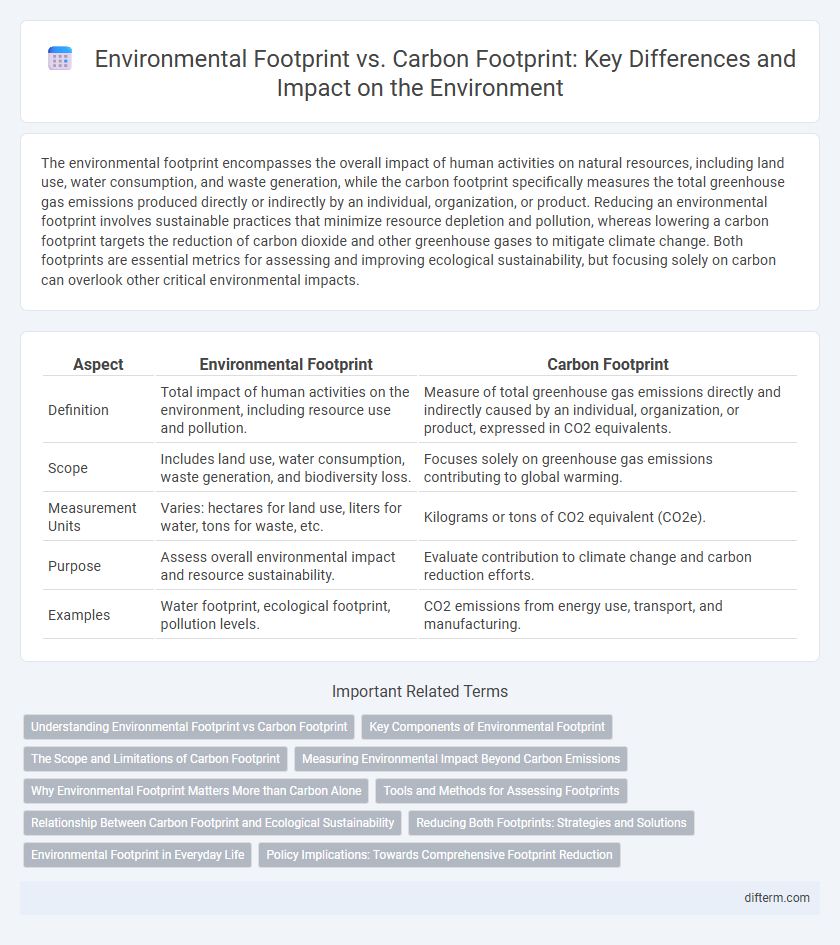The environmental footprint encompasses the overall impact of human activities on natural resources, including land use, water consumption, and waste generation, while the carbon footprint specifically measures the total greenhouse gas emissions produced directly or indirectly by an individual, organization, or product. Reducing an environmental footprint involves sustainable practices that minimize resource depletion and pollution, whereas lowering a carbon footprint targets the reduction of carbon dioxide and other greenhouse gases to mitigate climate change. Both footprints are essential metrics for assessing and improving ecological sustainability, but focusing solely on carbon can overlook other critical environmental impacts.
Table of Comparison
| Aspect | Environmental Footprint | Carbon Footprint |
|---|---|---|
| Definition | Total impact of human activities on the environment, including resource use and pollution. | Measure of total greenhouse gas emissions directly and indirectly caused by an individual, organization, or product, expressed in CO2 equivalents. |
| Scope | Includes land use, water consumption, waste generation, and biodiversity loss. | Focuses solely on greenhouse gas emissions contributing to global warming. |
| Measurement Units | Varies: hectares for land use, liters for water, tons for waste, etc. | Kilograms or tons of CO2 equivalent (CO2e). |
| Purpose | Assess overall environmental impact and resource sustainability. | Evaluate contribution to climate change and carbon reduction efforts. |
| Examples | Water footprint, ecological footprint, pollution levels. | CO2 emissions from energy use, transport, and manufacturing. |
Understanding Environmental Footprint vs Carbon Footprint
Environmental footprint encompasses the total impact of human activities on the planet, including resource consumption, waste generation, and ecosystem degradation, while carbon footprint specifically measures the volume of greenhouse gas emissions produced by an individual, organization, or product. Understanding the distinction is crucial for developing targeted sustainability strategies, as carbon footprint reduction addresses climate change, whereas environmental footprint reduction aims for broader ecological balance. Tools like Life Cycle Assessment (LCA) help quantify these footprints to guide effective environmental management and policy-making.
Key Components of Environmental Footprint
The environmental footprint encompasses key components such as water consumption, land use, energy consumption, and waste generation, offering a comprehensive view of human impact on ecosystems. Carbon footprint specifically measures greenhouse gas emissions, primarily carbon dioxide, from activities like fossil fuel combustion and deforestation. Understanding both footprints is crucial for developing sustainable practices that minimize overall ecological damage and promote resource conservation.
The Scope and Limitations of Carbon Footprint
The carbon footprint specifically measures greenhouse gas emissions generated by an individual, organization, or product, primarily focusing on CO2 and equivalent gases contributing to climate change. It excludes other environmental impacts such as water usage, land degradation, and biodiversity loss, which are included in the broader environmental footprint. Understanding these limitations is crucial for comprehensive sustainability assessments and effective environmental management strategies.
Measuring Environmental Impact Beyond Carbon Emissions
Environmental footprint encompasses a comprehensive evaluation of resource consumption, waste generation, and ecosystem disruption beyond just carbon emissions, offering a broader perspective on human impact. Measuring water usage, land degradation, biodiversity loss, and pollution levels provides critical data to address sustainability challenges holistically. Integrating these metrics into environmental policies ensures more effective mitigation strategies and promotes long-term ecological balance.
Why Environmental Footprint Matters More than Carbon Alone
Environmental footprint encompasses the total impact of human activities on natural resources, including land use, water consumption, and biodiversity loss, offering a comprehensive evaluation beyond greenhouse gas emissions. Carbon footprint measures only the greenhouse gases released, missing critical factors like resource depletion and ecosystem degradation that contribute to long-term planetary health. Prioritizing environmental footprint enables holistic sustainability strategies that address all dimensions of environmental impact, ensuring more effective preservation and restoration efforts.
Tools and Methods for Assessing Footprints
Environmental footprint assessment encompasses a broader evaluation of resource consumption, waste generation, and ecological impacts, employing tools like Life Cycle Assessment (LCA) and Material Flow Analysis (MFA) to quantify sustainability metrics. Carbon footprint measurement specifically targets greenhouse gas emissions, utilizing methodologies such as the Greenhouse Gas Protocol and specialized software like SimaPro and GaBi for precise carbon accounting. Integrating these tools enables organizations to identify hotspots, optimize processes, and implement effective strategies for reducing overall environmental impact.
Relationship Between Carbon Footprint and Ecological Sustainability
The carbon footprint quantifies greenhouse gas emissions generated by human activities, directly impacting ecological sustainability by accelerating climate change and biodiversity loss. Reducing carbon footprints through sustainable energy use and resource management supports ecological balance and conservation efforts. Effective mitigation of carbon emissions is essential for maintaining ecosystem services and achieving long-term environmental sustainability.
Reducing Both Footprints: Strategies and Solutions
Reducing environmental footprint requires comprehensive strategies targeting resource consumption, waste generation, and energy use across industries and households. Implementing renewable energy sources, promoting circular economy principles, and enhancing energy efficiency are effective solutions to simultaneously minimize carbon emissions and ecological impact. Adopting sustainable transportation options, minimizing single-use plastics, and supporting reforestation projects also contribute significantly to lowering both environmental and carbon footprints.
Environmental Footprint in Everyday Life
Environmental footprint encompasses the total impact of human activities on natural resources, including water usage, land consumption, and waste generation, beyond just greenhouse gas emissions measured by the carbon footprint. In everyday life, reducing the environmental footprint involves conscious choices like minimizing plastic use, conserving water, and supporting sustainable products that promote biodiversity and resource efficiency. Understanding and addressing environmental footprints supports holistic strategies for sustainable living and long-term ecological balance.
Policy Implications: Towards Comprehensive Footprint Reduction
Environmental policy must expand beyond carbon footprint reduction to address the broader environmental footprint, which includes water use, land degradation, and biodiversity loss. Implementing integrated metrics that capture multiple resource impacts enables more effective regulation and sustainable development strategies. Governments can incentivize industries to adopt circular economy principles, promoting comprehensive footprint reduction for long-term ecological resilience.
environmental footprint vs carbon footprint Infographic

 difterm.com
difterm.com